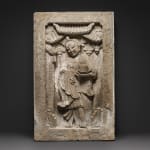Pair of Ming Dynasty sandstone tiles, 1368 CE - 1644 CE
Sandstone
124 x 77 x 10.2 cm
48 3/4 x 30 1/4 x 4 in
48 3/4 x 30 1/4 x 4 in
DL.2102
Upon leading a victorious rebellion against the foreign Mongul rulers of the Yuan Dynasty, a peasant named Zhu Yuanzhang seized control of China and founded the Ming Dynasty in 1368....
Upon leading a victorious rebellion against the foreign Mongul rulers of the Yuan Dynasty, a peasant named Zhu Yuanzhang seized control of China and founded the Ming Dynasty in 1368. As emperor, he established his capital at Nanjing and adopted the name Hongwu as his reign title. Hongwu, literally meaning “vast military,” reflects the increased prestige of the army during the Ming Dynasty. Culturally, the greatest innovation of the Ming Dynasty was the introduction of the novel. Developed from the folk tales of traditional storytellers, these works were transcribed in the everyday vernacular language of the people. Advances in printmaking and the increasing population of urban dwellers largely contributed to the success of these books. Architecturally, the most famous monument of the Ming Dynasty is surely the complex of temples and palaces known as the Forbidden City that was constructed in Beijing after the third ruler of the Ming Dynasty, Emperor Yongle, moved the capital there. Carved in high relief these exquisite tiles depict two youthful standing figures richly dressed and with elaborate headdresses against an ornate architectural background. The body posture and the serene facial expression denote a masterful attention to detail. With their round faces and sweet expressions these visually stunning figures create a playful atmosphere, displaying at the same time the high level of craftsmanship achieved by the artists of this period.



